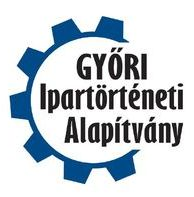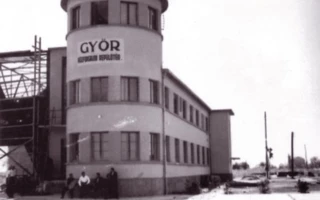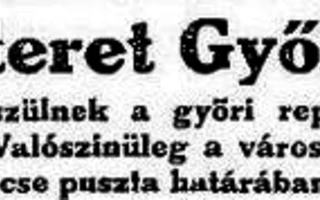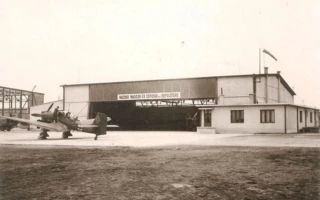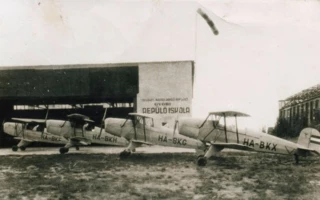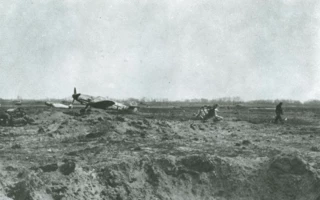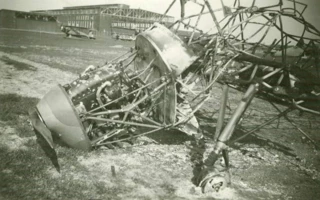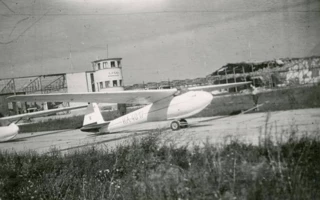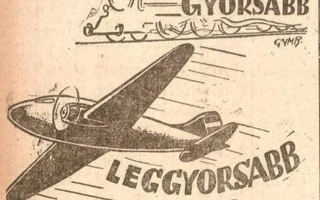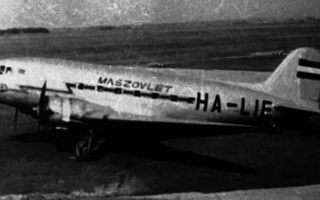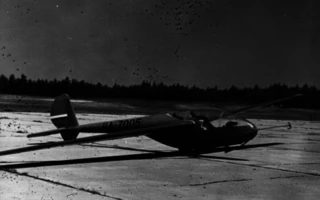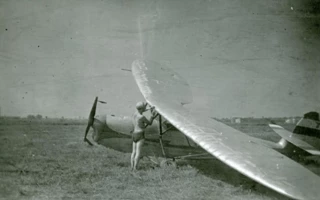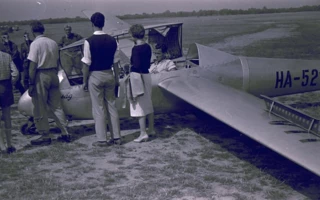Contact details
Foundation for Industrial History of Győr
Szent István út 10/a
Phone:
+3696520274
Fax: +3696520291
E-mail:
ipartortenet@ipartortenet.hu
Map
Győr-Hecsepuszta Airport
| Address of the memorial site, route planning | ||
| What can we see at the memorial site? | ||
| Brief overview | ||
| Detailed company history | ||
| Interesting facts | ||
| Literature, references | ||
| Related gallery |
| ADDRESS OF THE MEMORIAL SITE, ROUTE PLANNING |
| WHAT CAN WE SEE AT THE MEMORIAL SITE? |
Street view:

Audi Hungary Ltd.
Source: https://www.legifelvetel.hu/magyar/oldalak/magyarorszagi_autogyarak_madartavlatbol/
| BRIEF OVERVIEW |
|
The city of Győr decided in 1937 to build an airport on the outskirts of Győrszentiván, in Hecsepuszta. The Hungarian Wagon and Machine Works also participated in the implementation, and due to the expected high construction costs, financial support from the state, local society and the economic elite was also needed. The works were completed by June 1939, but it soon became clear that the capacity of the new airport was insufficient due to the increase in traffic. The airport met both military and civilian needs, thus also helping the lives of the citizens of the city of Győr. The airport, which was considered modern at the time, served its purpose until April 13, 1944. The American air force bombing caused such severe damage that pilots from the Győr military plant no longer flew into Hecsepuszta until the end of the war. It was used by sport aircraft and crop protection aircraft from 1946, then purchased by the Wagon Factory in 1968. The Audi car factory purchased the area from the Rába factory in 1993. Today, the AUDI Hungária factory complex can be seen on the site of the former airport. |
| DETAILED COMPANY HISTORY |

Guest house
Source: https://regigyor.hu/vegyes/gyori-polgari-repules/
Before World War II, Győr was at a disadvantage in terms of aviation opportunities, even compared to other large Hungarian rural cities. Many county seats in our country had already established airports by the mid-1930s, but only an Aero Club was operating in Győr. The first flying day was held in the city on September 30, 1928. As a result, the founding general meeting of the Győr Flying Club took place in May 1929. In 1939, the establishment of the Miklós Horthy National Aviation Fund provided the opportunity to start aviation nationwide. The Hungarian Wagon and Machine Works became involved in the repair and production of aircraft from 1937, which also made the establishment of an airport necessary. Governor Lipót Polniczky and Mayor Gyula Spǟth finally decided in favor of establishing the airport on February 20, 1937.

Title from the Győr National Newspaper, February 21, 1937
The director of the Wagon Factory, Arnold Barcza, was also involved in the discussion. Technical engineer Imre Farkas accompanied representatives of the political and economic elite on the site inspection. The technical authorities found a 70-acre estate next to the Industrial Canal, in Hecsepuszta, on the outskirts of Győrszentiván, suitable for the construction of an airport. The land was owned by the Benedictine community operating in Pannonhalma. During the completion of the site inspection and planning works, it turned out that the construction of the airport would cost 350 thousand pengő (land expropriation, landscaping, construction), and the city could not raise the funds for this from its own resources.

Title from the Győr National Newspaper, April 11, 1937
Citing the national defense interest, the state provided support to the city of Győr for the success of the construction. The preparations began in 1938, and the workers first had to move 50 thousand km3 of earth. After the land-planning works, the erection of buildings and hangars, the construction of public works, and the construction of roads leading to the facility could begin. The latter activity was financed by the city of Győr. It is interesting to note that the development works were supported by broad segments of society; for example, the employees of the Hungarian Wagon and Machine Works donated 1% of their monthly income in July 1938 to the construction of the airport. The ceremonial handover of the airport took place on Sunday, June 4, 1939, and was attended by Archduke Albrecht and his wife. For more information on the event, see: Lengyel Adrienn: The Győr Airport. In: Győri Szalon. Site visit. No. 2
https://www.gyoriszalon.hu/index.php?mact=News,cntnt01,detail,0&cntnt01articleid=1900

Airport. Photo: Győr Aero Club, Mária Stefánia Horváth
The works were completed by June 1939, but it soon became clear that the capacity of the new airport was insufficient due to the increase in traffic. However, in order to conduct the test flights smoothly, the recently established airport needed to be rebuilt and expanded.

Airport. Photo: Győr Aero Club, Mária Stefánia Horváth
At the beginning of World War II, the Hungarian Wagon and Machine Works was involved in the production of airframes for Messerschmitt Me 109 fighter aircraft in accordance with the German-Hungarian state treaty. After installing the engines from Weisz Manfréd Works, the finished warplanes were tested from an airfield near the factory.

Messerschmitt Bf 109 fighter
The country's first concrete runway was built at the airport in Hecsepuszta. The runway was 1,050 meters long and 103 meters wide, which proved to be more than enough for the Me 109 fighters to take off.

The airport as a training site before 1945 and

After 1945
The airport met both military and civilian needs, thus also helping the lives of the citizens of Győr. According to reports, the construction and then operational works provided a livelihood for approximately 3 thousand people.
The airport, which was considered modern at the time, served its purpose until April 13, 1944. The American air force bombing caused such severe damage that pilots from the Győr military plant no longer flew into Hecsepuszta until the end of World War II.

Airport after the bombing of April 13, 1944

Airport after the bombing of April 13, 1944

In 1946, the airport again received and launched public flights.
After the World War, thanks to the work of young people committed to aviation, the airport became usable within a short time. Bomb attacks on the Wagon Factory also caused significant damage to the aircraft factory, and the remaining aircraft were dismantled and transported to Germany by the retreating German troops. Young people flying within the framework of MADISZ (later OMRE, MRSZ, then MHSZ) collected aircraft parts from the surrounding villages and repaired the found aircraft. Flying resumed with these aircraft. From the end of 1946, the airport also started and received public flights. On December 16, 1946, the county and city leaders welcomed the first scheduled flight at the decorated airport. Regular flights started on the Budapest - Győr, Győr - Szombathely routes.

Győr-Sopron County Newspaper, April 3, 1951.
The airport was used for a short time by MALÉV (MASZOVLET aircraft), while the motorized flying school was established, so the use of the airspace and runways had to be regulated in order to ensure multi-purpose use.

The scheduled flight plane

Aero 45 machine
It was used by sport aircraft and the aircraft of the Plant Protection Service until 1968, when it was purchased by the Wagon Factory. The AUDI car factory purchased the industrial area from the Rába factory on April 21, 1993. Today, the AUDI Hungária factory complex can be seen at the former airport.


The compilation was partly based on the study by István Áldozó.
Continue to the detailed study
| INTERESTING FACTS |
|
Sport aircraft at the airport
The photos were provided by Endre Kozma.
See also:
|
||
| LITERATURE |
- • 1989. Ferenc Barla: Győr and aviation. MHSZ, Győr.
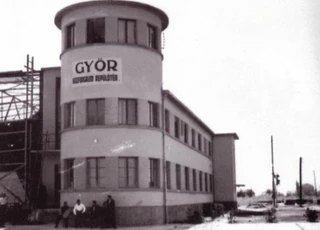
Related gallery
Back to the previous page!
